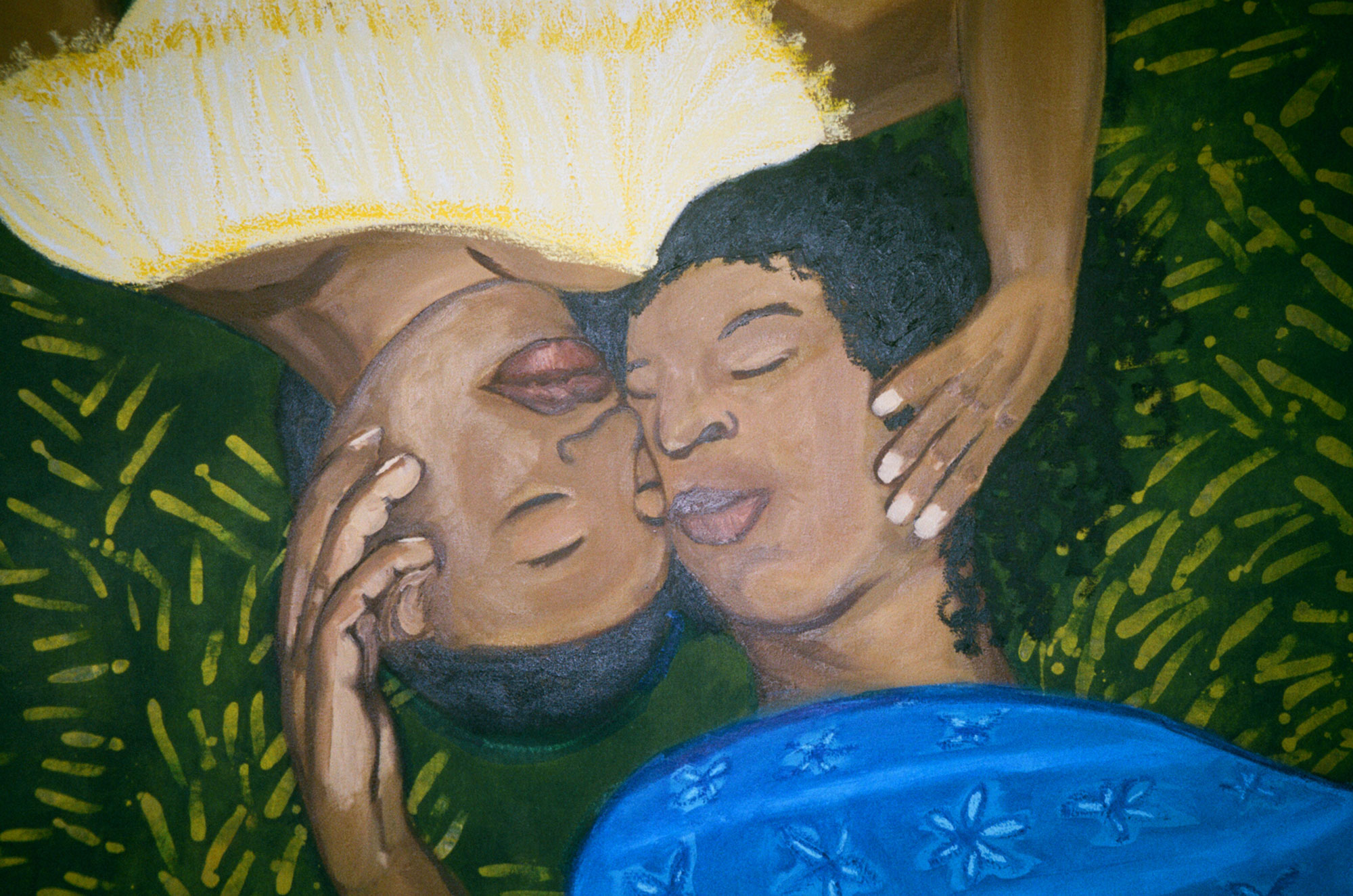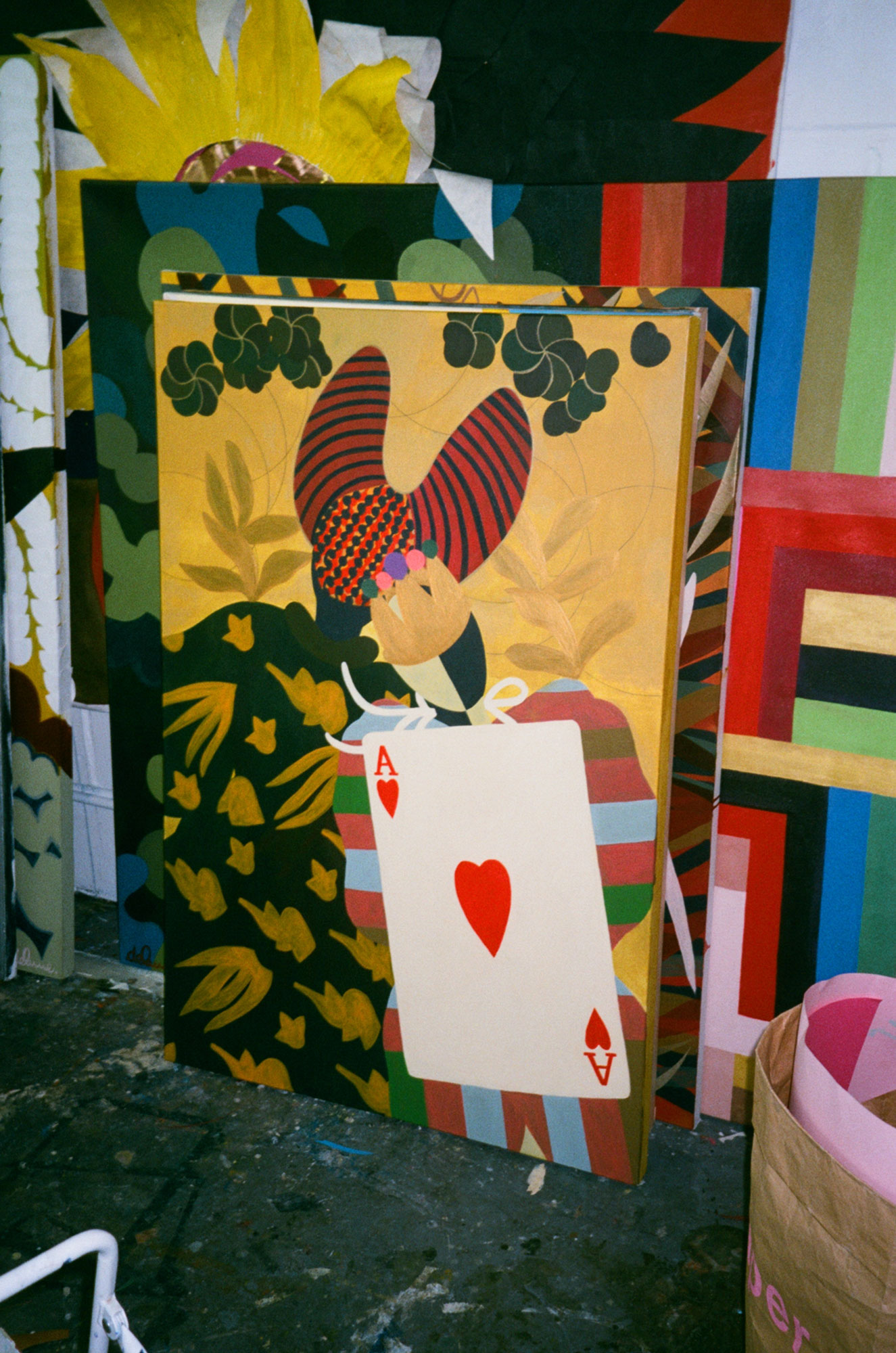









Gender fluidity, daily romance and black bodies.
South London based painter Sola Olulode captures daily life narratives, exploring the tangled dynamics of human interactions through her practice. Giving prominence to the representation of Black womxn and non-binary bodies, she creates an uplifting mood through the depiction of affectionate encounters. Reinforcing the mundane, Sola flags her fascination for the value of actions that are often overlooked: hugging, dancing, or sitting in the sun. Refusing to acknowledge the gaze of the viewers, her queer figures embrace their own intimacy and autonomy, expressed through the coexistence of colour transparencies and layers. Portrayed by way of deep indigo blues, yellows and brown backgrounds, individuals manifest a sense of unity which according to the artist is the ultimate celebration of self-awareness. Her techniques also suggest a synchronism with nature, particularly with her inclusion of fluid compounds. While her gestural strokes echo the motion of waves, her use of water as a crucial medium translates as a visual metaphor to the gender fluidity of her characters. In conversation with Sola, she unfolds her views on how romance between black people is often underrepresented by the media and how her work aims to express the beauty of these love stories, nurturing self-love as an essential prerogative to grow meaningful relationships.

BACKGROUND
Black identity and culture seem to be core references in your work. Having a Nigerian heritage and being born and raised in South London, one of the most diverse areas in the UK, how does the coexistence of multiple cultures in your background feed your creations?
My artwork is a documentation of my life experiences, so all of the different cultures I’ve lived around somehow feed into my practice whether it be who the figures are based off or the scenes I’ve created down to the colour schemes and textiles. Each aspect comes from some part of myself.
You have mentioned being exposed to art galleries and museums since a very young age through your parents, while your grandmother worked on artisanal techniques such as constructing mosaics. Growing up in regular contact with creativity, is there an interconnection between your choice to become a painter and the crafts that you have observed within your surroundings?
I guess that being exposed to the beauty and value of art at a young age inspired me. While others in my family used their creative expression just as a hobby, as I got older it seemed natural for me to gravitate towards it as a career choice.

A sense of unity, intimacy and womanhood are recurring elements in your series. Have any specific phases or experiences of your upbringing and artistic formation in Brighton inspired these narratives throughout your body of work?
During my time at the University of Brighton, I craved the intimacies I had with Black Womxn, so I painted many scenes dedicated to those relationships. Subconsciously longing for them and the significance they had in making me feel loved.
WORK
Painting intuitively, straight from the canvas without prior sketching, you recreate intimate interactions between figures caught dancing, cuddling or eating. Why is it important for you to recreate relatable daily life occurrences?
I think that I actually just paint my favourite activities to do, such as dancing, embracing, sleeping or eating. Those are my favourite ways to connect with people. They’re everyday moments, but I value them so much, and they’re scenes that everyone can relate to but sometimes get looked over. Even if the people in the paintings don’t reflect one’s identity, everyone should be able to relate to it in some way or another.

You paint on canvases of different dimensions, which range from the micro to the macro. This pattern is also reflected in the figures that you represent, which span both close ups and full shots. What dictates this disparate choice of proportions?
I like to have a range of sizes of paintings to be able to suit any kind of exhibition space or buyer. Painting large is always my favourite option, because I get to be more expressive with my body in the making of it and I think it’s also nice to see full size, larger than life sized paintings of black people taking up space in galleries. The tone of the piece I’m trying to convey also makes a difference to size and whether I need the figure’s whole body to tell the story or just a close up of two faces and the mood being set by their eyes.
Music is also a point of departure in your painting process. Does this influence your rhythm while painting, or help you to channel your brush technique to recreate flow and movement?
Since I often paint scenes of people dancing, I have to play music while painting. This allows me to get into the zone that they’re in and move my body in the same way when I’m painting. Or sometimes I just need it for the emotion. To hear a singer pour out their heart and capture their feelings in a painting.

Black bodies with gender neutral and androgynous facial features are one of the main elements of your compositions. Does your distinctive choice of painting queer and non-binary personalities spread a message of validation for these communities?
A lot of my work is about making people feel seen when they look at my paintings. The fluidity of gender is something I want to represent instead of confining my figures to a singular gender expression diversity.
Sisterhood is one of your signature themes, however your paintings often spotlight single figures. Is this individual depiction connected to the importance of self-awareness in a globalised atmosphere where people habitually live according to social norms? What visual elements in the composition reinforce your community narrative?
My paintings are all about relationships and I think that the most important is the one we have with ourselves, self-love. You can have all the friends and loved ones in the world but if you don’t have acceptance and respect for yourself, in my opinion, you won’t be able to truly experience their love.

‘Love Couples’’ is your newest series which reflects on romantic emotions and represents the beauty of black love. How has the unprecedented social distancing measures influenced your creative vision in terms of representing the dynamics of intimacy? Placing these figures in joyful ecosystems, are you aiming to advocate for love while projecting the complexities of their identities?
Social distancing makes me value physical intimacy more than ever. The couples in my images live in a bubble separated from reality and now that bubble seems even further away from my real life.
‘If Beale Street Could Talk’ and ‘Moonlight’ by Berry Jenkins are romantic and coming-of-age dramas capturing the spirit of black relationships. Have they both contributed to the foundation of your ‘Love Couples’ series? Why does the Jenkin direction speak to you? Which aesthetic choices from his vision resonate with you the most?
Watching Barry Jenkins’ films made me realise how deprived I had been of seeing positive images of black love and witnessing it gave me hope. Being in love is one of the great treasures we can experience in life and the media often neglects black people from thinking they can experience this in a healthy way. To see black people and especially dark skin people experience love and happiness warmed my heart in such a strong way. The cinematography of these was perfect; the use of colour and the way the black skin tones were lit with such care (there’s a long history of black people being underserved by cameras). All of these layers inspired my work a lot.


The Adire technique, which is a blue tie dye cloth typical from Yorubaland, is a process you often apply especially through your QTPOC dancing scenes. As this palette is often associated with melancholy, why did you decide to apply this particular shade to recreate an uplifting atmosphere instead?
Colours have different meanings for different communities and people. For me, using Indigo and blue was merely an aesthetic choice to begin with. The association of this palettes to night time worked for me when I was painting the club scenes. Other people’s interpretations of blue as a melancholic colour didn’t really come into my mind initially.
From mastering the use of blue and yellow to more recently transitioning to green, would you say that your journey through a reduced palette of colours somehow mirrors your personal growth? What mood does each step of the journey represent?
The more the colours appear, the more confident I am in my painting. At the beginning I had to limit myself to develop certain techniques, but now I have more knowledge and I can apply what I’ve learnt to different materials and confidently experiment with new colours.


Looking at your paintings often feels like snipping into a private moment. Is turning the viewer into an accidental witness of these intimate scenarios an attempt to make them feel a sense of discomfort, voyeurism or intrusion?
Not at all, the viewer takes part in the celebration of the scene. Too often these relationships are forced into being hidden as if there is something to be ashamed of. I want to normalise seeing images of queer people being affectionate.
FUTURE
Transparencies, layering and textures contribute to recreate a sensorial impact for the viewers. Has this led you to form a specific format for your future exhibitions and projects? Moving forward, how do you think the public will be able to experience your work at its fullest potential?
Unfortunately, I don’t think my work translates very well when it is photographed. It has to be viewed in real life to get the full energy of the piece.

During lockdown you have found amusement in experimenting with monoprints. Have you considered creating a monoprint series? What other techniques have you developed during this time?
I only really did monoprints. I’ve always liked to do them. I have a big passion for printing and would love to release a print series as well as learning other practices like screen printing or etching.
Considering your attachment to films as a source of input to conceptualize your works, have you considered using it as a medium to manifest your vision in the future?
I would love to make a film one day. I just don’t have the time or the idea just yet but I’m working on it!
05.09.2020
Words by Vanessa Murrell
Related
Studio Visit

Sola Olulode
Interview

